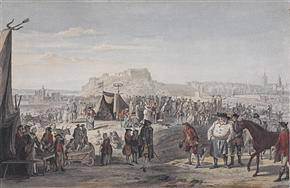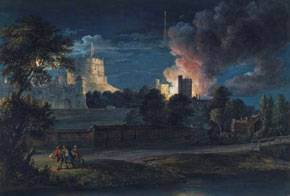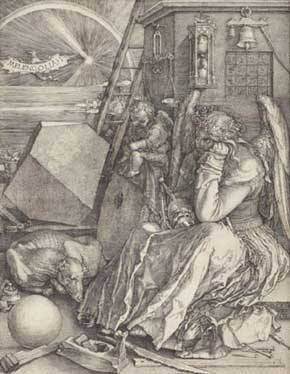
Paul Sandby: ‘Horse Fair on Bruntsfield Links’ Edinburgh (National Gallery of Scotland)

Paul Sandby: Windsor Castle from Datchet Lane on a Rejoicing Night (1786)
The Royal Collection © 2009 Her Majesty Queen Elizabeth II
Paul Sandby (1731-1809) – Picturing Britain
National Gallery of Scotland present a major exhibition celebrating the bicentenary of the artist Paul Sandby (1731-1809). A pioneer landscape painter and brilliant innovator with watercolour, Sandby played a key role in promoting the appreciation of spectacular scenery across Britain and inspired many later travellers and artists. Although the significance of his work has long been acknowledged, this is the first exhibition to include and analyse the full range of Sandby’s achievement
7 November 2009 – 7 February 2009
]]>
Paul Sandby was born in Nottingham in 1731. He visited Scotland early in his career as a part of the Military Survey, which through map making, formed part of the campaign to control the country after the 1745 Jacobite Rebellion. During his time as the Survey’s chief draughtsman he was based in Edinburgh and produced numerous ground-breaking landscape and genre studies. These works became well known through prints, and stand at the beginning of the rich tradition of depicting the drama and beauty of Scottish landscape – which was later developed by artists such as Runciman, Nasmyth, More and Turner. Sandby also came to know the work of importantEnlightenment figures, such as the poet Allan Ramsay and the architect Robert Adam. Key works by Sandby exploring Scottish subjects in the exhibition include Roslin Castle (Yale Center for British Art), Horse Fair on Bruntsfield Links, Edinburgh (National Gallery of Scotland), and part of the ‘Great Map’ of Scotland of c.1753 (British Library).
Following his time in Scotland, Sandby settled in London where he worked as a teacher, landscape painter and printmaker, forging a considerable reputation. Thomas Gainsborough considered him ‘the only Man of Genius… [for] real Views from Nature’. From the 1760s he made many highly finished watercolours and gouaches at Windsor, which are in a number of cases the outstanding works of his career. They include Sandby’s dramatic View of Windsor on a Rejoicing Night of 1768 (Royal Collection), which was painted in the year the artist became a founder member of the Royal Academy
Sandby has often been considered the ‘father’ of watercolour painting in Britain; he refined the use of the medium and employed it to explore a broader range of subject matter than any previous artist in the country. He delighted in the study of rural and urban views, street scenes, royal parks and ancient castles, and always retained an interest in fascinating anecdotal details – which embrace the fashions, occupations and entertainments of the people he encountered. Picturing Britain features over one hundred loans, including oil paintings, watercolours, gouaches, prints and sketchbooks, coming from all the major collections which house his work: The Royal Collection, The British Museum, The British Library, The Victoria and Albert Museum and The Yale Center for British Art. It also includes some outstanding works from private collections, which have never previously been published.
This exhibition was organised by Nottingham City Museums and Galleries in association with the National Galleries of Scotland, Edinburgh. Its catalogue has been published by the Royal Academy of Arts, and in 2010 the Mellon Centre in London will host a complementary academic conference. The research for the exhibition and accompanying catalogue have been generously funded by The Paul Mellon Centre for British Art.
Follow us on:


